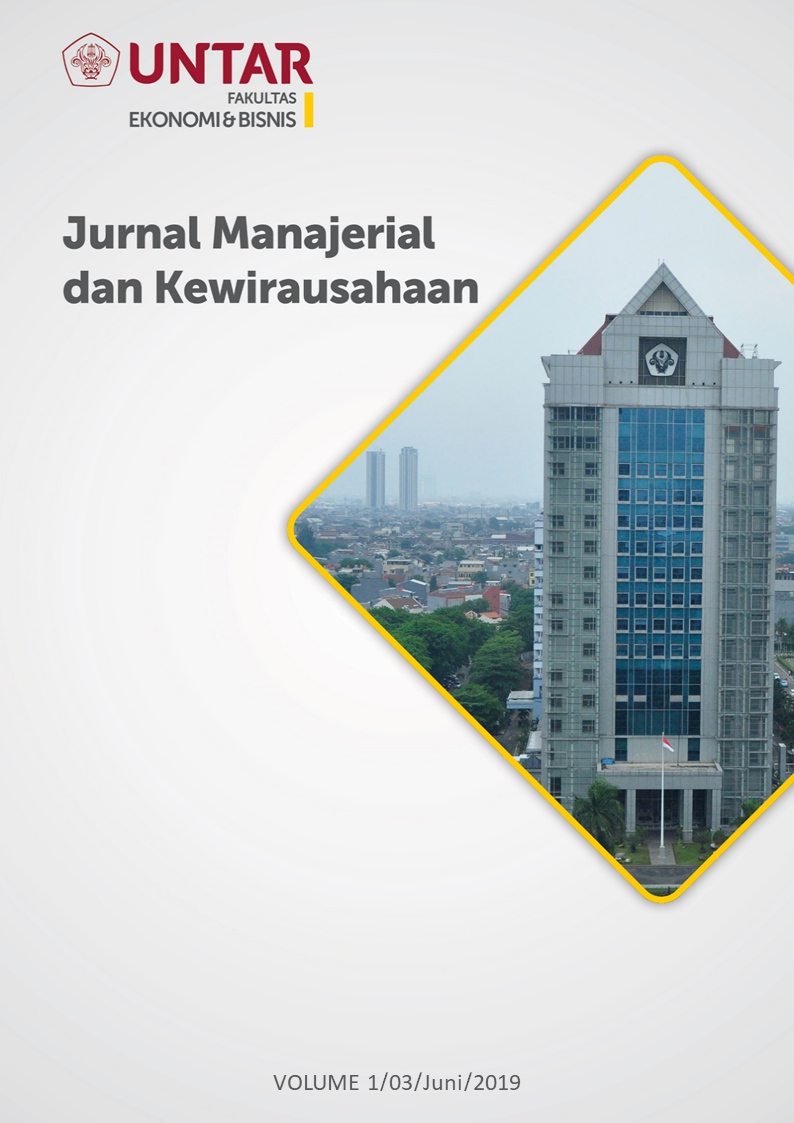Pengaruh Mediasi Terhadap Pengalaman Sebelumnya Dengan Intensi Berwirausaha Sosial
Main Article Content
Abstract
The purpose of this research is to know the effect of prior experience, empathy, moral obligation, social entreprenenur self-efficacy, and social support on social entrepreneurial intention. The research sample consisted of 350 students of the Faculty of Economics at Tarumanagara University. The sampling technique uses judgmental sampling. The data analysis used was structural equation modeling (SEM) with the Professional SmartPLS tool version 3.0. The results show that prior experience has an influence on the intention of social entrepreneurial. Moral obligation, social entrepreneur self-efficacy, and social support provide a mediating effect on the influence of prior experience with the intention of social entrepreneurial, while empathy does not provide a mediating effect on the influence of previous experience with the intention of social entrepreneurial
Tujuan penelitian ini adalah untuk mengetahui apakah pengalaman sebelumnya, empati, moral obligation, social entrepreneur self-efficacy, dan dukungan sosial dapat memberikan pengaruh terhadap intensi kewirausahaan sosial. Sampel penelitian ini terdiri dari 350 mahasiswa Fakultas Ekonomi di Universitas Tarumanagara. Teknik pengambilan sampel menggunakan judgmental sampling. Analisis data yang digunakan adalah structural equation modeling (SEM) dengan alat bantu SmartPLS Profesional versi 3.0. Hasil menunjukkan bahwa pengalaman sebelumnya meberikan pengaruh terhadap intensi kewirausahaan sosial. Moral obligation, social entrepreneur self-efficacy, dan dukungan sosial yang dirasakan memberikan efek mediasi terhadap pengaruh pengalaman sebelumnya dengan intensi kewirausahaan sosial, sedangkan empati tidak memberikan efek mediasi terhadap pengaruh pengalaman sebelumnya dengan intensi kewirausahaan sosial.
Article Details
This work is licensed under a Jurnal Muara Ilmu Ekonomi dan Bisnis Creative Commons Attribution-ShareAlike 4.0 International License.,/p>
References
Ardichvili, A., Cardozo, R. and Ray, S. (2003), “A theory of entrepreneurial opportunity
identification and development”, Journal of Business Venturing, Vol. 18 No. 1, pp. 105-
Bandura, A. (1977), “Self-efficacy: toward a unifying theory of behavioral change”,
Psychological Review, Vol. 84 No. 2, pp. 191-215,
available at:
http://dx.doi.org/10.1037/0033-295X.84.2.191
Beck, L. and Ajzen, I. (1991), “Predicting dishonest actions using the theory of planned
behavior”, Journal of Research in Personality, Vol. 25 No. 3, pp. 285-301, available at:
https://doi.org/10.1016/0092-6566(91)90021-H
Drayton, W. (2002), “The citizen sector: becoming as entrepreneurial and competitive as
business”, California Management Review, Vol. 44 No. 3, pp. 120-132, available at:
https://doi.org/10.2307/41166136
Giles, M., McClenahan, C., Cairns, E., and Mallet, J. (2004). An application of the Theory of
Planned Behaviour to blood donation: The importance of self-efficacy. Health Education
Research, 19(4), 380–391.
Hemingway, C.A. (2005). “Personal values as a catalyst for corporate social entrepreneurship.
Journal of Business Ethics”, 60(3), 233–249.
Hockerts, K. (2015), “The social entrepreneurial antecedents scale (SEAS): a validation study”,
Social Enterprise Journal, Vol. 11 No. 3, pp. 260-280, available at:
https://doi.org/10.1108/SEJ-05-2014-0026
Hockerts, K. (2017), “Determinants of social entrepreneurial intentions”, Entrepreneurship
Theory and Practice, Vol. 41 No. 1, pp. 105-130, available at:
https://doi.org/10.1111/etap.12171
Jean Paolo G. Lacap, Hendrati Dwi Mulyaningsih, Veland Ramadani, (2018). "The mediating
effects of social entrepreneurial antecedents on the relationship between prior experience
and social entrepreneurial intent: The case of Filipino and Indonesian university
students", Journal of Science and Technology Policy Management, Vol. 9 Issue: 3,
pp.329-346, https://doi.org/10.1108/JSTPM-03-2018-0028
Kraimer, M. L., Wayne, S. J., and Jaworski, R. A. (2001),“Sources of support and expatriate
performance: The mediating role of expatriate adjustment”,Personnel Psychology, Vol.
,pp. 71–99.
Kraus, S., Filser, M., O’Dwyer, M. and Shaw, E. (2014), “Social entrepreneurship: an
exploratory citation analysis”, Review of Managerial
Mair, J. and Marti, I. (2006). Social entrepreneurship research: A source of explanation,
prediction, anddelight. Journal of World Business, 41(1), 36–44.
Mair, J. and Noboa, E. (2006). Social entrepreneurship: How intentions to create a social
venture get formed. In J. Mair, J. Robinson, & K. Hockerts (Eds.), Social
entrepreneurship (pp. 121–136). New York: Palgrave MacMillan.
Mulyaningsih, H.D. and Veland, R. (2017), “Social entrepreneurship in Islamic context”, Book
chapter of: Entrepreneurship and Management in an Islamic Context, Springer, Berlin,
pp. 143-158.
Preston, S.D., Bechara, A., Damasio, H., Grabowski, T.J., Stansfield, R.B., Mehta, S., et al.
(2007). The neural substrates of cognitive empathy. Social Neuroscience, 2(3-4), 254–
Schlaegel, C. and Koenig, M. (2014). Determinants of entrepreneurial intent: A meta-analytic
test and integration of competing models. Entrepreneurship Theory and Practice, 38(2),
–332.
Tran, A.T. and Von Korflesch, H. (2016), “A conceptual model of social entrepreneurial
intention based on the social cognitive career theory”, Asia Pacific Journal of Innovation
and Entrepreneurship, Vol. 10 No. 1, pp. 17-38, available at:
https://doi.org/10.1108/APJIE-12-2016-007
Wood, S. (2012). Prone to progress: Using personality to identify supporters of innovative
social entrepreneurship. Journal of Public Policy & Marketing, 31(1), 129–141.
Zhao, H., Seibert, S.E., and Hills, G.E. (2005). The mediating role of self-efficacy in the
development of entrepreneurial intentions. The Journal of Applied Psychology, 90(6),
–12



